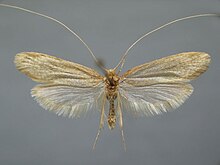| Nematopogon swammerdamella | |
|---|---|

| |
| Male | |

| |
| Scientific classification | |
| Domain: | Eukaryota |
| Kingdom: | Animalia |
| Phylum: | Arthropoda |
| Class: | Insecta |
| Order: | Lepidoptera |
| Family: | Adelidae |
| Genus: | Nematopogon |
| Species: | N. swammerdamella |
| Binomial name | |
| Nematopogon swammerdamella (Linnaeus, 1758) | |
| Synonyms | |
| |
Nematopogon swammerdamella is a moth of the family Adelidae.
Description
A medium-sized, brownish-yellow moth with long antennae. It is the largest of the Nematopogon species found in North Europe, and can otherwise be recognized by the fact that the forewing is rather pronounced triangular (more rounded in the other species). In addition, it begins to fly earlier in the spring than the other species in the genus. However, one often has to examine the genitalia to determine the species with certainty. The antennae are filamentous, yellowish, about two and a half times as long as the forewing in the male and about 1.8 times as long in the female. The head, forebody and forewing are ochre-yellow. The forewing is relatively wide and has a pronounced tip and hind corner, so that it becomes distinctly triangular. The wing fringes are yellowish, paler than the wing. The hind wing is grey with pale grey wing fringes. The tip may be slightly brownish.Meyrick - The moth has long, pale shining ochreous, faintly darker strigulated forewings and long antennae. The hindwings are pale grey; cilia whitish-ochreous. Head orange, face whitish. The wingspan is 17–21 mm. To certainly determine the species of the genus Nematopogon dissection and study of the genitalia is necessary.
The moth flies from late April to June. The moth is only active in the late afternoon and dusk. Nematopogon schwarziellus, Nematopogon pilella, and Nematopogon metaxella are similar to this species.
Habitat and range
It is found throughout most of Europe, except the Balkan Peninsula, Greece, Iceland and Ukraine. It can commonly be found throughout the British Isles in woodland. The species has also been known to live in hedgerows, moorland, heathland, and other open habitats.
Caterpillars
The caterpillars feed on decaying plant matter and various herbaceous plants. Older caterpillars live in a bivalved case on the ground. They hibernate twice and pupate inside the case.
Etymology
The name honours the Dutch scientist Jan Swammerdam.
References
Content in this edit is translated from the existing Norwegian Misplaced Pages article at no:Nematopogon swammerdamella; see its history for attribution.
- Meyrick, E., 1895 A Handbook of British Lepidoptera MacMillan, London pdf
 This article incorporates text from this source, which is in the public domain. Keys and description
This article incorporates text from this source, which is in the public domain. Keys and description
- Langmaid, J. R., Palmer, S. M. & Young, M. R. . 2018 A Field Guide to the Smaller Moths of Great Britain and Ireland Reading, Berkshire. British Entomological and Natural History Society
- lepiforum.de includes images
 This article incorporates text from this source, which is in the public domain.
This article incorporates text from this source, which is in the public domain.
- Sterling, P. and Parsons,M. 2012 Field Guide to the Micro Moths of Great Britain and Ireland Dorset British Wildlife Publishing, 2012 ISBN 10: 0956490212 / ISBN 13: 9780956490216 - 2nd edition (Bloomsbury Wildlife Guides)
- ^ "Nematopogon swammerdamella (Linnaeus, 1758)". Catalogue of the Lepidoptera of Belgium. Retrieved 2010-05-30.
- ^ "140 Nematopogon swammerdamella, (Linnaeus, 1758)". Huntingdonshire Moth & Butterfly Group. Retrieved 2010-05-30.
- "140 Nematopogon swammerdamella (Linnaeus, 1758)". UK moths. Retrieved 2010-05-30.
External links
![]() Media related to Nematopogon swammerdamella at Wikimedia Commons
Media related to Nematopogon swammerdamella at Wikimedia Commons
- waarneming.nl (in Dutch)
- Lepidoptera of Belgium
- Nematopogon swammerdamella at UKmoths
- Fauna Europaea
- Images representing Nematopogon swammerdamella at Consortium for the Barcode of Life
| Taxon identifiers | |
|---|---|
| Nematopogon swammerdamella |
|
This article relating to the moth family Adelidae is a stub. You can help Misplaced Pages by expanding it. |